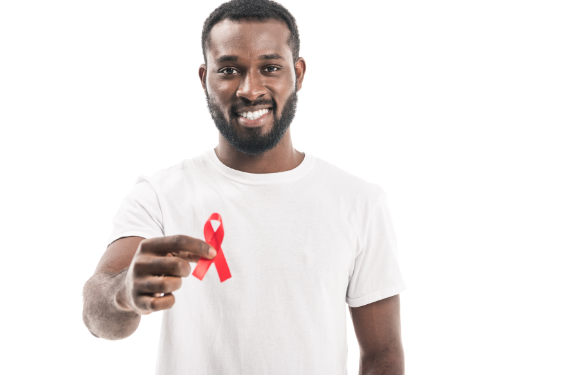Tuesday, February 7 was National Black HIV/AIDS Awareness Day, one of over a dozen national awareness days that focus on different aspects of the ongoing HIV/AIDS epidemic. The most recognizable of these may be World AIDS Day, commemorated annually at the beginning of December.
These awareness days are important because, “While all Americans are affected by the HIV epidemic, some populations bear an especially heavy burden and account for the largest numbers of HIV infections,” according to the Center for Disease Control.
Overrepresentation in New Infections
Data published by the CDC shows African Americans are “by far the most affected racial/ethnic population.” Data from 2009 highlights this: African Americans accounted for 44 percent of new HIV infections even though they represent only 14 percent of the overall population. This rate of infection is “almost eight times as high as that of whites.”
Black men who have sex with men represent the second largest population of new HIV infections. Black heterosexual women are the fourth largest population group and Black straight men the fifth largest.
The term “men who have sex with men” is used in CDC surveillance systems because it focuses on the behaviors the center has identified as most impacting HIV transmission rates, rather than how individuals self-identify.
Nearly half (48 percent) of new HIV infections among injection drug users were African Americans. Injection drug users represented nine percent of new HIV infections in the same data set.
Testing, Prevention, and Treatment Trends
The U.S. Department of Health and Human Services (HRSA) urges the use of this awareness day to, “Highlight the progress of HIV testing, prevention, and treatment efforts and consider our ongoing challenges.”
The first National Black HIV/AIDS Awareness Day was commemorated 24 years ago. Then, there were 33 million cases worldwide and the World Health Organization designated the disease as the fourth deadliest killer.
Now, with the advent of antiretroviral treatment, mother-to-child transmission rates have dropped 95 percent since the 1990s. Additionally, of the Black clients served by the federal Ryan White HIV/AIDS Program, for low-income individuals, 87.2 percent are virally suppressed, according to Dr. Laura Cheever, associate administrator for the department’s HIV/AIDS Bureau. This is a significant increase from 63.3 percent virally suppressed in 2010. An individual who is virally suppressed cannot sexually transmit HIV.
Despite this progress, Cheever stresses that, “We’ve never had such high rates of all sexually transmitted diseases in this country as we have right now.” Cheever recommended that sexually active individuals take the medication pre-exposure prophylaxis (PrEP) to prevent getting HIV and use condoms to prevent other STIs such as syphilis and gonorrhea.
Unfortunately, African American communities access prevention measures at lower rates. Among African Americans who could benefit from taking PrEP, only eight percent do so, compared to 23 percent of the identified population, according to a joint statement from the CDC and the National Center for HIV, Viral Hepatitis, STD, and TB Prevention.
The joint statement also recognized that, “Intersecting racial and economic factors create structural barriers” unique to African American communities. Medical racism and discrimination from health care providers contribute to high levels of medical mistrust in the overall health care system.
Additional challenges highlighted by HRSA are “social and structural barriers, including racism, discrimination, homophobia, [and] HIV stigma.”
To fully combat the HIV epidemic, the CDC recognizes that, “HIV prevention can only be achieved by addressing these disparities and working to achieve health equity.”
San Diego County
The HIV Planning Group (HPG) of San Diego indicated in a report that as of December 31, 2020, there were 14,061 people in the County living with diagnosed HIV and an additional 1,392 persons estimated to be living with undiagnosed HIV infection.
In 2020, there were 302 residents who were newly diagnosed with HIV, representing just under one new diagnosis, on average, every day. This represents a 40 percent decrease from 2016 data.
Locally, African Americans are overrepresented in HIV infection rates. Though demographically less than 5 percent of the population, they account for “12 percent of incident cases and almost 13 percent of prevalent cases,” according to the same report. Additionally, this group had the “highest percentage of both unmet need and in care but not virally suppressed, at 35% and 27%, respectively.”
The report identified unique challenges to the African American MSM population, including “no geographic area or neighborhood . . . there isn’t even a gay-identified bar for African Americans.” Significantly, “a history of disenfranchisement, marginalization and health inequity [which] lead to low self-efficacy and low levels of health literacy.”
A 2020 focus group identified family dynamics and cultural beliefs as additional challenges to stigma for African American HIV positive men to be open about an HIV diagnosis. Lastly, medical mistrust and a perception that HIV testing may be interpreted as “admission of engaging in stigmatized behavior” contribute to African American MSM’s overrepresentation in HIV epidemiological data.
Signs of hope identified in the HPG report celebrated “long-standing organizations” such as the San Diego African American Nurses Association and the Faith-Based Action Coalition for building “HIV awareness and promoting HIV testing within the African American and faith communities.”
Last year, to address medical system mistrust, the HPG developed and approved Justice, Equity, Diversity, and Inclusion (JEDI) principles with three main focuses: A dedication to an inclusive culture for its members, HIV Service Contractors, and the HIV service provider workforce; the vision and intention of the JEDI Principles; and the principles that frame mindful practices among the its membership, service providers, and stakeholders.
The mission of the HPG is to plan HIV prevention, care, and treatment services to reduce the impact of HIV in San Diego County. Anyone in San Diego County can apply to become a member.
A list of San Diego County HIV prevention, treatment and care service providers is available here.









